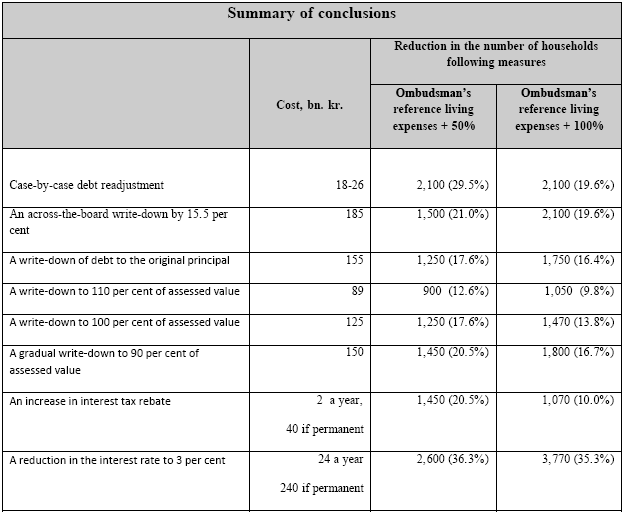Report from a Working Group of Experts appointed by the Prime Minister for an assessment of household debt problems
In consultation between the Government and representatives of the parliamentary opposition it was decided on October 15th to convene a Working Group of Experts from ministries, financial institutions and the Household Association to assess the cost of various approaches to resolving the problem of household debt. Mr. Sigurður Snævarr, Economic Counsellor to the Prime Minister, chairs the Working Group.
The main conclusions of the report of the Working Group are as follows:
- Close to 100,000 households reported real property on their tax returns in 2009, of which nearly 30,000 reported no mortgage debt.
- Almost 73,000 households reported mortgage debt amounting to a total of 1,200 billion krónur.
- The average mortgage debt amounted to nearly 18 million krónur.
- Mortgage debt is highest amongst people in their thirties, averaging 23 million krónur for couples and 17 million for singles.
- Over 20,000 homeowners owe more than the assessed value of their property, 28 per cent of mortgage debtors or 20 per cent of total homeowners.
- Interest payments reported on 2009 tax returns amounted to 59.5 billion krónur and interest tax credits to 12 billion krónur, about a third of interest payments.
- Arrears have increased in all financial institutions. Arrears exceeding 90 days amount to 10.4 per cent in commercial banks, 6.4 per cent with the Housing Finance Fund and 4.0 per cent in pension funds.
- The Working Group gauged the number of households in financial distress by subtracting from their disposable income a crude estimate of minimum living expenses. This residual is an estimate of a household's capacity to support its debt service. A family is defined to be in financial distress if this capacity falls short of its payment obligations.
- The Debtors' Ombudsman's guidelines for minimum living expenses for different family types were the reference point for living expenses. As these guidelines omit various expenses, the working group added 50 per cent to these expenses as its lower reference and 100 per cent as its higher reference. In addition, the cost of running one car was added in case families reported car ownership.
- By the lower reference point about 10,700 households are facing payment problems or are in distress, representing 14.7 per cent of households with mortgages or 11 per cent of the total number of homeowners. Gauging by the higher reference, the number rises to some 17,800 families, 24.5 per cent of households with mortgages, or around 18 per cent of homeowners.
- About half of the households facing payment problems owe more than their property is worth. More than 80 per cent of the households facing payment problems purchased their property in the years 2004-2008.
- More than 80 per cent of the households facing payment problems are in the capital area or on the Reykjanes peninsula.
- Most households facing payment problems are relatively low-income.
The Working Group considered 11 different ways to address the problem:
- A case-by-case debt readjustment.
- An across-the-board write-down of debt by 15.5 per cent.
A write-down of debt to the original principal.
- A write-down to 110 per cent of the assessed value.
- A write-down to 100 per cent of the assessed value.
- A gradual write-down to 90 per cent of assessed value.
- An increase in interest tax rebate.
- A reduction in the interest rate to 3 per cent.
A two-step approach (sale-/purchase option)
- Income contingent loan scheme.
- Asset expropriation and the write-down through an arbitration ruling.
The last three options could not be assessed within the framework set up by the working group.
The table below summarises the cost of each option in billion krónur and the reduction in the number of problem households for each approach as well as the total number of households that would be helped with each approach (no numbers are presented for the last three options).


